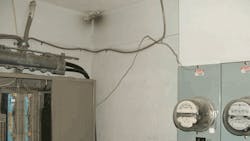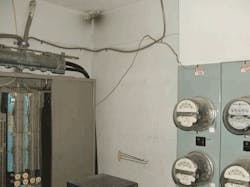What's Wrong Here? Hint: I Have Some Shocking News to Share
How well do you know the Code? Think you can spot violations the original installer either ignored or couldn't identify? Here's your chance to moonlight as an electrical inspector and second-guess someone else's work from the safety of your living room or office. It's your turn to identify the violation.
Hint: Hello. This is the operator. I have some shocking news to share with you.
Find the Answer
In accordance with 250.94, an intersystem bonding termination for connecting a minimum of three intersystem bonding conductors required for other systems shall be provided external to enclosures at the service equipment or metering equipment enclosure.
Exception: In existing buildings, if any of the intersystem bonding and grounding electrode conductors required by 800.100(B)(2) exist, installation of the intersystem bonding termination is not required. An accessible means external to enclosures for connecting intersystem bonding and grounding electrode conductors shall be permitted at the service equipment by at least one of the following means:
1) Exposed nonflexible metallic raceways
2) An exposed grounding electrode conductor
3) Approved means for the external connection of a copper or other corrosion-resistant bonding or grounding electrode conductor to the grounded raceway or equipment
As noted in 800.100(B)(2), "A bonding device intended to provide a termination point for the grounding electrode conductor (intersystem bonding) shall not interfere with the opening of an equipment enclosure. A bonding device shall be mounted on non-removable parts. A bonding device shall not be mounted on a door or cover even if the door or cover is non-removable."
The telephone system bonding/grounding wire attached to the cover screw at the top of the meter enclosure definitely interferes with the opening of the cover. The phone system would lose its ground/bond connection every time the meter enclosure cover needed to be removed for maintenance or servicing of the electrical system. This could result in a difference of potential between the two systems and could result in a shock or fire hazard.
> Try Another QuizAbout the Author

Russ LeBlanc
Owner
Russ started in the electrical trade as an apprentice in 1985. He worked his way up to become a Journeyman Electrician and then eventually became a Master Electrician and Licensed Construction Supervisor. In 1999 Russ become an Electrical Instructor for The Peterson School of Engineering in Massachusetts where he developed his passion for teaching, and quickly became Department Head of Electrical Instruction. Russ has taught thousands of apprentices, electricians, engineers, inspectors, and other electrical professionals during his career as an instructor. He continues to provide electrical professionals with Electrical Code seminars, Arc-Flash Awareness training seminars and educational material through his LeBlanc Consulting Services in North Reading, MA whose specialty is educating electricians. He has been an active member of the NFPA Electrical Section and has authored hundreds of National Electrical Code proposals and comments which have become Code rules to improve the safety for the electrical industry. Russ is also an IAEI certified Electrical Inspector.
Please visit www.russleblanc.net for more information.

